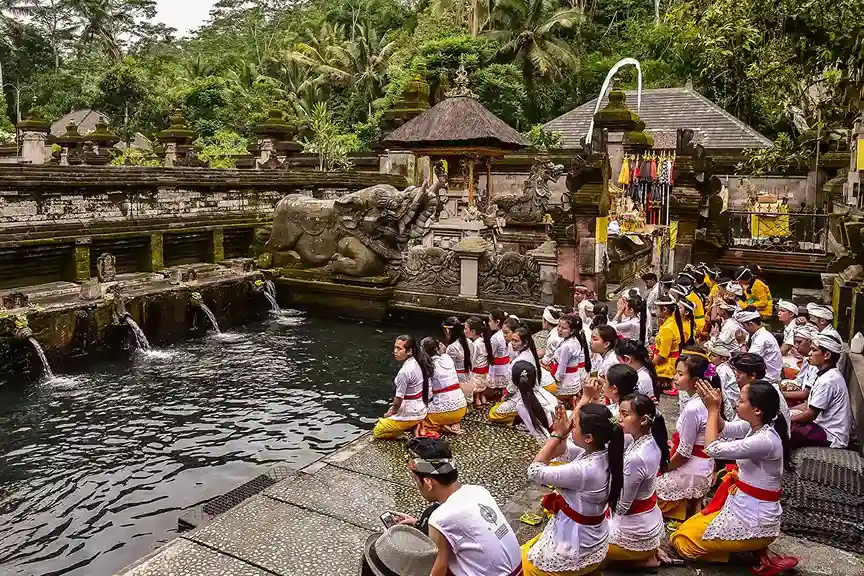
Tirta Empul Temple: A Guide to Bali’s Sacred Water Purification Ritual
Bali is home to many sacred sites, but few are as revered and spiritually significant as Tirta Empul Temple. Nestled in the lush highlands of central Bali, this centuries-old Hindu temple is renowned for its sacred water springs and deep-rooted cultural heritage. Whether you’re a traveler seeking a spiritual experience or a history enthusiast eager to explore Bali’s rich past, Tirta Empul offers an unforgettable journey into the island’s religious traditions.
Beyond its stunning temple architecture, what truly sets Tirta Empul apart is its role in holy water purification rituals. Pilgrims and visitors from all over the world come to bathe in its crystal-clear pools, believing in the water’s power for spiritual healing and renewal. To fully appreciate this remarkable site, let’s delve into its history, significance, and what makes it a must-visit destination in Bali.
Table of Contents
ToggleThe Historical and Spiritual Significance of Tirta Empul Temple
Located in the Gianyar Regency near Ubud, Tirta Empul Temple dates back to 962 AD, during the Warmadewa Dynasty. The temple was built around a natural spring, which is said to have been created by the Hindu god Indra to restore the health of his warriors. The name “Tirta Empul” translates to “holy water spring,” reflecting the temple’s primary purpose as a place of purification and devotion.
As one of Bali’s most significant Hindu temples, Tirta Empul remains an active place of worship. The temple is dedicated to Vishnu, the Hindu god of water, and local Balinese Hindus perform ritual cleansing in the pools, following a sacred bathing sequence. The belief in the water’s spiritual healing properties continues to attract both worshippers and curious visitors looking to experience this ancient tradition firsthand.
A UNESCO-Recognized Cultural Treasure
While Tirta Empul Temple itself is not individually listed as a UNESCO World Heritage Site, it is part of the larger cultural landscape of Bali’s Subak irrigation system, which has received UNESCO recognition. This highlights the temple’s deep connection to Bali’s spiritual and agricultural traditions, where water is revered not only for sustenance but also for purification and balance.
For those exploring Bali’s spiritual sites, Tirta Empul stands as a symbol of devotion, history, and the enduring power of holy water purification rituals. Whether you’re participating in a cleansing ceremony or simply admiring the intricate temple architecture, visiting Tirta Empul offers a profound glimpse into the heart of Balinese culture.
The Ritual of Melukat: Purification at Tirta Empul Temple
Visiting Tirta Empul Temple is more than just an exploration of Bali’s rich cultural heritage—it is an opportunity to experience a profound spiritual tradition. One of the most revered practices at the temple is the Melukat ritual, a sacred cleansing ceremony that symbolizes purification and renewal. For centuries, Balinese Hindus and spiritual seekers have come to this holy site to bathe in its sacred pools, believing in the power of the holy water purification to cleanse their minds, bodies, and souls.
Whether you are a devotee following religious customs or a traveler curious about Bali’s spiritual side, understanding the meaning behind the spiritual renewal process at Tirta Empul will allow you to fully appreciate the temple’s significance. Let’s take a closer look at the step-by-step process of Melukat ritual, its deeper spiritual meaning, and why this tradition remains a vital part of Balinese culture.
Understanding the Meaning of Melukat
In Balinese Hinduism, the Melukat ritual is an ancient form of spiritual cleansing, aimed at removing negative energy, bad karma, and emotional burdens. The word “Melukat” comes from the Old Javanese term “lukat,” which means to cleanse or purify. This practice is deeply rooted in the belief that water, especially holy water purification, has the divine ability to purify the soul and restore balance in one’s life.
At Tirta Empul Temple, the purification process is guided by temple priests and follows a sacred order. Pilgrims and visitors alike are welcome to participate, but it is important to approach the ritual with respect and sincerity, as it holds deep spiritual significance for the Balinese people.
Step-by-Step Guide to the Purification Process
1. Preparing for the Ritual
Before entering the sacred pools, visitors must dress in a traditional sarong and sash, which can be rented at the temple entrance. It is essential to approach the ritual with a pure heart and an open mind, setting an intention for spiritual renewal before beginning the cleansing process.
2. Making Temple Offerings
Balinese Hindus prepare temple offerings of flowers, incense, and rice as a sign of gratitude and devotion. These offerings, known as “canang sari,” are placed at the temple shrines before entering the water, symbolizing respect for the deities and a request for blessings.
3. Entering the Sacred Pools
The holy water purification at Tirta Empul Temple consists of several fountains, each believed to have different cleansing properties. Participants move from one fountain to another, rinsing their heads under the flowing water while reciting prayers or personal affirmations. It is important to follow the correct sequence, as some fountains are reserved exclusively for specific rituals.
4. Completing the Cleansing Ceremony
After passing through all designated fountains, participants exit the sacred pools and change into dry clothes before proceeding to the final prayer area. Here, a temple priest may offer additional blessings to complete the purification process.
The Spiritual Significance of Holy Water Purification
Water is considered the source of life and a divine element in Hinduism, representing purity and renewal. The cleansing ceremony at Tirta Empul is more than just a physical act—it is a ritual of rebirth, where individuals let go of negative influences and emerge with a refreshed spirit. Many who undergo the Melukat ritual describe a deep sense of peace, clarity, and emotional healing.
Whether you seek spiritual renewal or simply wish to witness an ancient tradition firsthand, participating in purification at Tirta Empul offers a meaningful and unforgettable experience. This sacred practice continues to be a testament to Bali’s deep-rooted spiritual traditions, inviting visitors to connect with the island’s mystical energy and the power of holy water purification.
Exploring the Architectural Beauty of Tirta Empul Temple
Stepping into Tirta Empul Temple is like entering a realm where history, spirituality, and artistry merge seamlessly. This ancient Hindu temple, known for its sacred courtyard and stunning stone carvings, stands as a testament to Bali’s rich cultural heritage. Beyond its religious significance, Tirta Empul Temple is an architectural masterpiece that showcases the elegance of Bali temple design, reflecting centuries of devotion and craftsmanship.
Understanding the architectural layout of Pura Tirta Empul allows visitors to appreciate not only its function as a place of worship but also its role in preserving Balinese artistic traditions. From the grand temple gates to the intricately carved shrines, every corner of this site holds a deeper meaning. Let’s take a closer look at the key sections and distinctive elements that make the temple an extraordinary representation of the Hindu temple Bali architecture.
The Layout of Tirta Empul Temple
Like many traditional Balinese temples, Tirta Empul Temple follows a tri-mandala layout, a concept in Bali temple design that divides the sacred space into three main sections:
1. Jaba Pura (Outer Courtyard)
The journey begins at the entrance, where visitors pass through an ornate temple gate adorned with stone carvings depicting mythological figures. This area serves as a transition from the outside world into the spiritual sanctuary.
2. Jaba Tengah (Central Courtyard and Purification Pools)
This is the heart of the temple and the most famous section, where the sacred courtyard houses the purification pools used in the Melukat ritual. The crystal-clear waters emerge from a natural spring beneath the temple, reinforcing the site’s spiritual essence. Rows of water spouts carved in ancient style pour into the pools, inviting worshippers and visitors alike to participate in a purification ceremony.
3. Jeroan (Inner Sanctum)
Beyond the pools lies the holiest part of the temple, where Hindu shrines stand in honor of deities. This secluded space is reserved for prayer and religious ceremonies. The shrines are adorned with traditional Balinese ornamentation, reflecting the artistic mastery that defines Bali temple design.
The Signature Elements of Balinese Architecture
Several defining characteristics of Hindu temple Bali architecture can be found throughout Tirta Empul Temple, including:
1. Temple Gates (Candi Bentar & Kori Agung)
The towering temple gates serve as both physical and symbolic barriers, marking the transition into sacred space. The split gateway (Candi Bentar) at the entrance and the roofed gateway (Kori Agung) leading to the inner sanctum are iconic features of Balinese temples.
2. Stone Carvings and Reliefs
Every inch of the temple’s surface is adorned with intricate stone carvings, depicting scenes from Hindu mythology, floral motifs, and protective spirits. These artistic details reflect the devotion of Balinese sculptors to preserving their cultural identity.
3. Sacred Courtyard with Natural Spring
Unlike many temples, the Tirta Empul Temple is built around a natural spring, which continuously feeds the purification pools. The sacred waters have flowed for over a thousand years, making the temple a unique fusion of spiritual and architectural elements.
The architectural beauty of Tirta Empul Temple extends beyond its visual appeal—it embodies the spiritual and cultural depth of Balinese traditions. Every temple gate, sacred courtyard, and stone carving tells a story of faith and artistic excellence. Whether you visit for its religious significance or to admire its craftsmanship, exploring this ancient site offers an unforgettable glimpse into the timeless beauty of Bali temple design.


